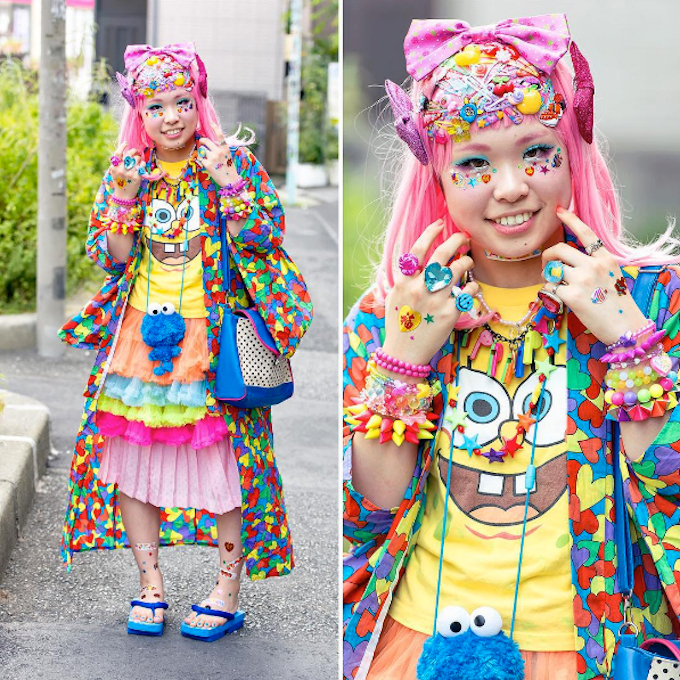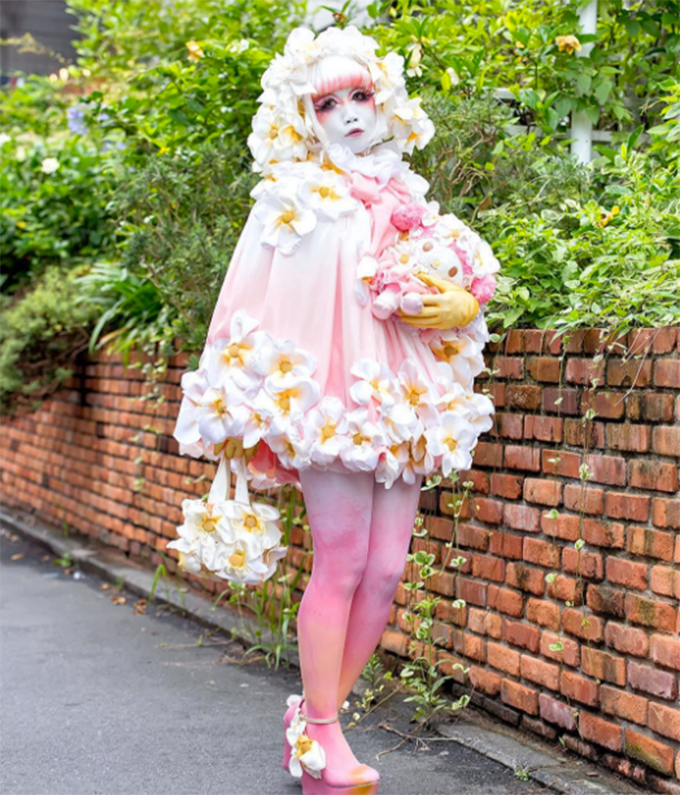A is for Ayano Sudo: This 28-year-old Japanese photographer is often compared to a kawaii Cindy Sherman. Sudo’s shiny, sparkling portraits showcase the crazy, beautiful, and often grotesque visual effects of kawaii with the help of her “superpowers”: Photoshop and an arsenal of colorful wigs. The artist tells i-D, “The more I transform and manipulate my images, the more kawaii my portraits become.”
Photography Ayano Sudo
B is for BABYMETAL: Unlike anything you’ve seen before, these teen rock-goddesses from Japan mix sick riffs with Lolita style to create something that seems like it could only exist in a Tarantino film. With semi-sweet headbangers like “Gimme Chocolate!,” it’s no wonder Lady Gaga and Iron Maiden are bonafide BABYMETAL-heads.
Photography Piczo
C is for crunchyroll: The Netflix of anime and manga offers no shortage of pink-haired schoolgirls with bread fetishes and side hustles as space patrolers, mermaids, and motorcycle gang members. Explore action-packed kick-ass kawaii adventures, and revisit classic girl-power series like Sailor Moon.
D is for Decora Girls: Imagine going into a Claire’s and trying on everything in the store at once. If you were a Decora girl, that would just be your morning routine. This eye-catching Harajuku subculture takes accessorizing to the the next level. The most dedicated Decora girls are known to wear hundreds of barrettes at a time, sew plushies to their layers of bright clothing, and top it all off with a kawaii band-aid or surgical mask for good measure.

via @TokyoFashion
E is for Emoji: Punctuating any text with a peace sign or cherry blossom emoji instantly adds kawaii flair, but the history of the “moji” (the Japanese word for character) begins in the early 90s, when Nintendo fans got creative with the keyboard in at attempt to represent Kirby — the bubbly alien from Planet Popstar — with parentheses and periods: <( -‘.’- )>. Today, an entire lexicon of punctuation kaomoji, cartoon emoji, and even big butted Kimoji have created a new, universal language and entirely changed the way we communicate.
Photography Dan Wilton
F is for FRUiTS: This tasty magazine has been showcasing Harajuku street style since 1997, and played a large part in introducing kawaii culture to the mainstream. Over the years, FRUiTS has documented the evolution of Japan’s style subcultures and developed into a cult fan-zine, while founder and photographer Shoichi Aoki continues to shoot a fresh crop of style stars on Instagram.
G is for Genderless Kei: Known as Genderless Kei, an emerging section of Japanese youth is rejecting the gender binary, and their country’s traditional beauty ideals, to create a new standard of kawaii for men and women alike. The men aren’t trying to present as women, and vice versa, but rather shatter gender divisions altogether. With contact lenses, sparkly nail polish, and face-editing apps, anyone can be the genderless manga idol of their Snapchat-filtered dreams.

via @Peey
H is for Hatsune Miku: Hatsune Miku is the most popular girl in Japan. The impossibly proportioned 16-year-old megastar appears in her own video games, is the voice of Nyan Cat, performs live around the world, has recorded over 100,000 original songs, and has opened Lady Gaga‘s ARTPOP Ball. How? She’s a hologram, with a voice controlled by synthesizer software. It’s hard to argue with the virtual idol’s unstoppable success; the turquoise-haired humanoid recently got a haute-couture makeover by Riccardo Tisci.
I is for i-D Nippon: The next chapter of Japan’s rich style history begins with the newly launched i-D Nippon. Shift your gaze east and learn a lesson in originality from Tokyo’s club kids, find out what it means to be a woman in Japan today, and get your dose of kawaii right here.
J is for Janette: Harajuku-based, Spokane-born stylist Misha Janette is the creator of the blog Tokyo’s Fashion Diaries, which bridges the gap between Japanese and American style by providing an insider’s view on Tokyo trends. The BoF 500 journalist and social media star also hosts Kawaii International on Japan’s NHK World TV channel, and owns the experimental wig brand Plumb.
K is for Kyary Pamyu Pamyu: Sweeter than candy, better than cake, Kyary Pamyu Pamyu is a 23-year-old fashion blogger turned chart-topping J-Pop star — and the pogo-stick jumping, dessert-eating embodiment of kawaii. In fact, the doe-eyed dancer is so damn adorable that the capital of cute appointed her Harajuku’s official Kawaii Ambassador.

Photography Piczo
L is for Lolita: Inspired by the romantic fashion of the Victorian and Edwardian eras, Lolita style is not about looking provocatively sexy, but rather cute or elegant in a way that deflects the male gaze. While the ultimate style tribe has its roots in Japan, it has now blossomed into an international phenomenon, with conventions around the world, and subgenres of doll-like “Elegant Goths,” “Princess Lolitas,” and petticoat wearing punks.
M is for Miyazaki: Manga artist Hayao Miyazaki is the co-founder of Studio Ghibli, the anime powerhouse behind eight of the highest grossing Japanese films of all time. After 30 years in the business, the Academy Award winning animator and director may (possibly) have retired, but his influence on fashion, film, and flipping the script for female heroines, in films like Princess Mononoke and My Neighbor Totoro, will keep us Spirited Away forever.

Still from Spirited Away
N is for Neko Atsume: 20 years after the launch of the Tamagotchi, this new virtual pet-sitting game has gone viral in the same confusing way, racking up 10 million downloads on the app store. The game’s goal is to lure as many virtual cats to your virtual yard as possible — using toys, catnip, and digital fish — and to add screenshots of your new furry friends to your scrapbook. It’s as simple as it sounds, but also addictively adorable.
O is for Oozeki: Dubbed “Japan’s Most Viral Teenager,” 19-year-old Reika Oozeki is changing how Japanese girls use social media to express themselves. Her six–second Vines are fun and relatable in any language because there’s nothing more kawaii than laughter.
P is for Puffy Eyes: Not to be mistaken with the dark under-eye circles of sleep-deprivation, “puffy eyes,” or “smiling eyes” are a coveted asset for achieving a fresh-faced kawaii look. For those who don’t naturally have the enviable fat pouches of a J-Pop idol, this insanely popular sticky tape by beauty brand Mejutu can make lower eyelids puff up instantly.
Q is for Queer: For the recent South Park episode “Tweek x Craig,” creators Matt Stone and Trey Parker asked fans to submit works of yaoi (translation: “boy love”) — a subgenre of manga depicting fictional sexual affairs between two straight men — featuring these two minor characters. For reasons that can only be explained by “because, the Internet,” fan fiction about Tweek and Craig has appeared online since 2005. It was refreshing to see a rare moment of sincerity in the typically crass cartoon series, which used the episode to shine a light on the LGBTQ community. Creek4eva.
R is for Robot fashion: Kyunkun is a 20-year-old mechanical engineering student and fashion blogger taking wearable technology to the next level. Exploring her passion for robots, she accessorizes her school uniform with circuit breakers and motorized wings that serve no function other than looking kawaii. The electronic designer hopes to live in a world where fashion and robots can exist together in one harmonious #ootd. Watch Kyunkun’s android accessory “METCALF clione” in action here.
Photo via Kyunkun
S is for Shironuri: Named for the mask-like face paint worn by its adopters, shironuri (translation: “white painted”) is a morbidly beautiful performative lifestyle made famous by Harajuku street style fixture Minori, who combines elements of geisha ritual, kabuki theater, and nature in her poetically distressed designs.

via @minorim00n
T is for Takashi Murakami: Known for his smiling painted flowers, his 13-year collaboration with Louis Vuitton, and his role as Kanye’s unofficial Graduation-era creative director, Takashi Murakami has become a kawaii staple on every level of American culture. Though his most prominent works are colorful painted canvases, he entered the third dimension for his first feature-length film, 2015’s creepy-kawaii Jellyfish Eyes, and the accompanying video for the movie’s theme song, by Pharrell and Hatsune Miku.
Photography Hisayuki Amae
U is for Uniforms: In the often regimented culture of mainstream Japan, naturally it’s every girl’s mission to make their school uniform as kawaii as can be. “Bad gals” or “kogals” rock micro skirts, loose socks and bad attitudes, while anime often star kawaii-fied school girls. Even the Japanese army has tried to make its look a little cuter.
V is for Visual Kei: Visual Kei is an aesthetics-based genre of J-rock in which a band’s onstage theatrics are just as important to their success as their actual music — if not more important. 80s-inspired glam rockers like By-Sexual and Glay embrace androgyny with flamboyant arrangements of teased hair, smokey black eye makeup, and layers of leather and heavy-metal jewelry.
W is for Wota: If Beliebers and Directioners joined forces, their super-army of iPhone wielding teenage girls couldn’t light a match to Japan’s legions of wota. Wota is a type of otaku — the slang term for an unhealthily obsessed fan — dedicated to worshipping Japanese pop stars. Much of a wota’s self-identity is based on proving their knowledge of and love for their favorite group by memorizing dance moves and stocking up on merch, but a wota’s dedication goes far beyond creating your standard fan account. Aside from studying every intimate detail of their idols’ lives, wotagei are known to go to extreme lengths to get closer to their idols. J-pop groups like Perfume and AKB48 often hold handshaking events for the totally obsessed.
X is for Xuba: Udoli is an emerging subculture created by kawaii girls of African descent. Taking its name from the Zulu word for “doll-like,” the culture adapts a Japanese aesthetic with modifications for natural hair and darker skin tones. Xuba girls are the wild and colorful udoli inspired by the rave scene and electronic music. Known for being edgy and breaking the rules, xuba girls rock neon hair, rainbow clothing, and tribal face paint.
Y is for Yamanba: Inspired by bleach-blonde sun-kissed California girls, ganguro girls emulate a sexually liberated western ideal by lightening their hair and wearing dark bronzer with white lipstick — a radical rejection of the traditional porcelain-skinned Japanese beauty standard. Taking this girls-gone-wild aesthetic a step further, yamanba girls (yamanba translates to “mountain witch”) are rebellious teen runaways who live outside society and pride themselves on their promiscuity and perceived poor personal hygiene.

via banbaandmanba
Z is for Zombies: Zombie idol Akari Aoki is so kawaii it’s scary. After many failed attempts at becoming a traditional idol, Aoki now haunts the streets of Tokyo in a sailor uniform—like those in 2001 cult horror film Stacy: Attack of the Zombie Schoolgirls—and managed to revive her career from the dead. Kowai, meaning “scary,” or kimo, meaning “gross,” are used to describe the creepy-cute style that enters into Hot Topic territory.
Still via Youtube
Credits
Text Taylor Ford
